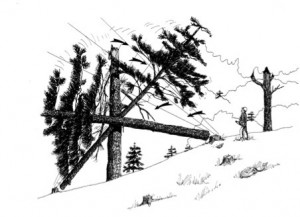BACKGROUND: A logging company employee was felling trees with a chain saw on a warm summer day in the Appalachians.
PERSONAL CHARACTERISTICS: The 43-year-old employee had worked for his present employer about five months. His normal job was trimming trees that had already been felled. Although he was an experienced chain saw operator, he had limited experience felling trees. He was wearing chain saw chaps and a hard hat.
UNSAFE ACT OR CONDITION: On a prior day, another worker had lodged a small pine tree (approximately 8-inch stump diameter) while attempting to fell it. The tree had fallen up the slope and lodged in a dead pine tree.
The employee was working uphill from the lodged tree. He felled a large pine tree (approximately 20-inch diameter) downhill toward the lodged tree.
ACCIDENT: The falling tree struck the branches of the dead pine tree and knocked the lodged tree loose. The now dislodged pine fell uphill toward the logging employee.
INJURY: The top of the dislodged tree struck the employee on his face and chest, causing severe injuries. He died en route to the hospital.
RECOMMENDATIONS FOR CORRECTIONS:
- Lodged, dead, and other hazard trees should be flagged with tape as “killer trees,” and all personnel should keep at least two tree-lengths away from the area until the hazard trees are mechanically dislodged and grounded.
- Manual tree felling is always dangerous. Extreme caution and alertness are always necessary, to determine potential hazards, appropriate felling direction, and a clear path of retreat.
- The logging contractor must establish and enforce this “danger tree” policy on his or her logging operation.
 Courtesy of the Forest Resources Association: https://www.forestresources.org/
Courtesy of the Forest Resources Association: https://www.forestresources.org/
